Community Assessment Essay: 3804NRS, Mt. Isa, Trimester 1, 2019
VerifiedAdded on 2023/01/17
|10
|2637
|26
Essay
AI Summary
This essay presents a community needs assessment conducted for Mt. Isa, Queensland, Australia. The assessment analyzes data from the Australian Bureau of Statistics, focusing on social determinants of health such as education, employment, and community distribution. The study identifies Aboriginal and Torres Strait Islanders as a vulnerable sub-group and outlines strategies for engagement and needs assessment within this community. The essay emphasizes the importance of health promotion planning tailored to address the specific needs of the identified group, involving healthcare professionals, community representatives, and governmental support. The goal is to improve healthcare access and promote sustainable development within the community. The paper also discusses various strategies such as interviews, surveys and group discussions to understand the needs of the vulnerable group and to increase their participation in community affairs. The assessment concludes with a call for increased awareness and community involvement to achieve positive healthcare outcomes.
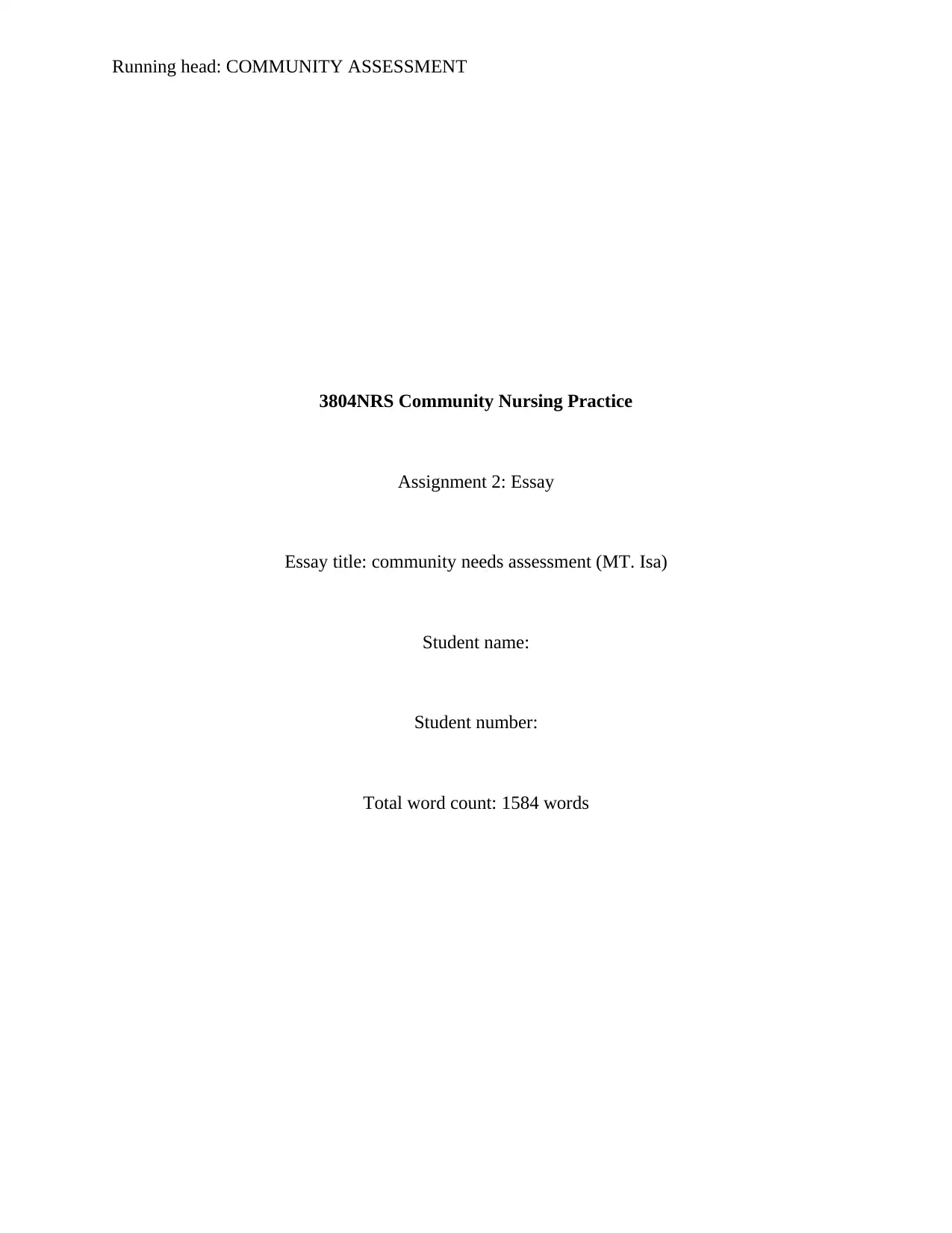
Running head: COMMUNITY ASSESSMENT
3804NRS Community Nursing Practice
Assignment 2: Essay
Essay title: community needs assessment (MT. Isa)
Student name:
Student number:
Total word count: 1584 words
3804NRS Community Nursing Practice
Assignment 2: Essay
Essay title: community needs assessment (MT. Isa)
Student name:
Student number:
Total word count: 1584 words
Paraphrase This Document
Need a fresh take? Get an instant paraphrase of this document with our AI Paraphraser
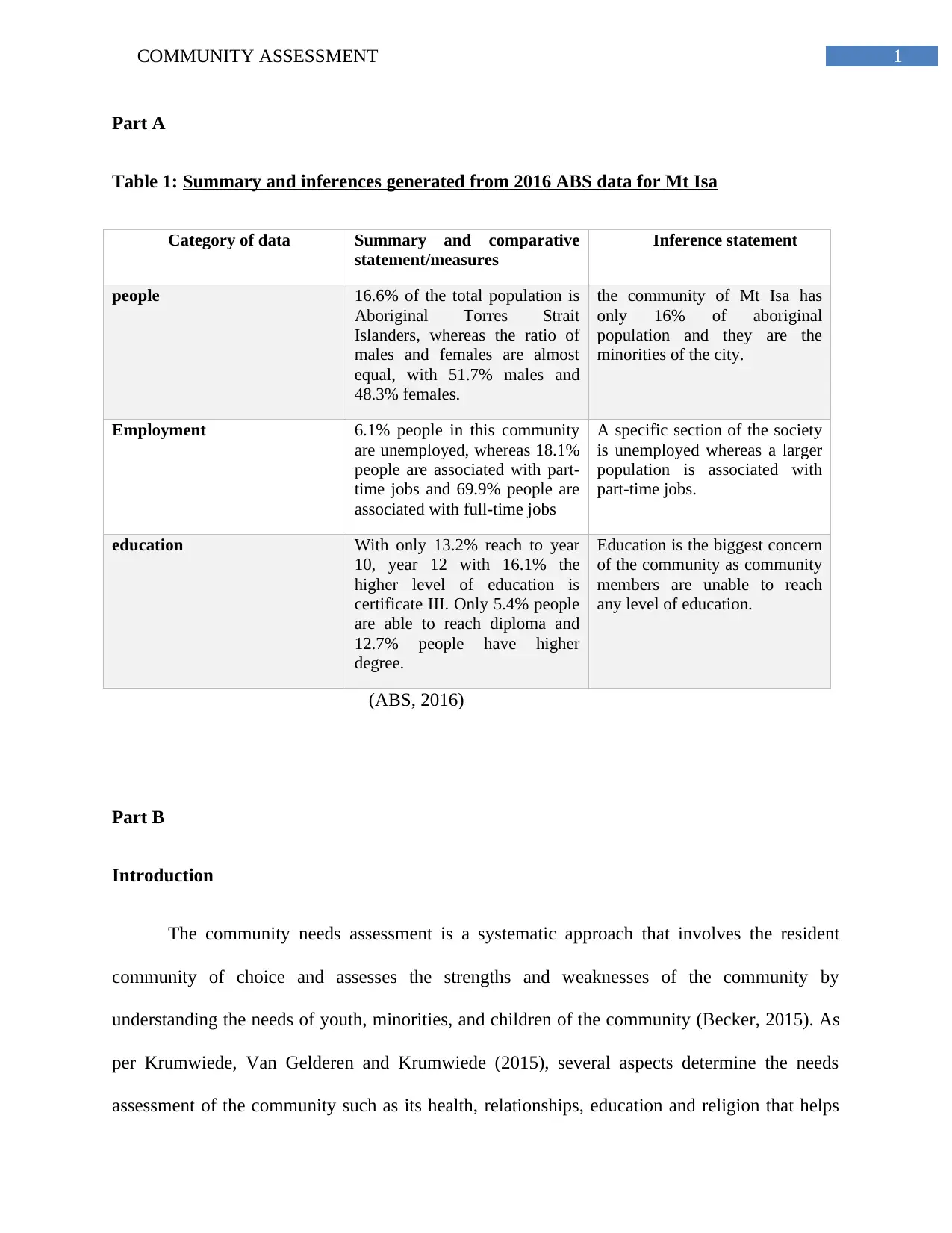
1COMMUNITY ASSESSMENT
Part A
Table 1: Summary and inferences generated from 2016 ABS data for Mt Isa
Category of data Summary and comparative
statement/measures
Inference statement
people 16.6% of the total population is
Aboriginal Torres Strait
Islanders, whereas the ratio of
males and females are almost
equal, with 51.7% males and
48.3% females.
the community of Mt Isa has
only 16% of aboriginal
population and they are the
minorities of the city.
Employment 6.1% people in this community
are unemployed, whereas 18.1%
people are associated with part-
time jobs and 69.9% people are
associated with full-time jobs
A specific section of the society
is unemployed whereas a larger
population is associated with
part-time jobs.
education With only 13.2% reach to year
10, year 12 with 16.1% the
higher level of education is
certificate III. Only 5.4% people
are able to reach diploma and
12.7% people have higher
degree.
Education is the biggest concern
of the community as community
members are unable to reach
any level of education.
(ABS, 2016)
Part B
Introduction
The community needs assessment is a systematic approach that involves the resident
community of choice and assesses the strengths and weaknesses of the community by
understanding the needs of youth, minorities, and children of the community (Becker, 2015). As
per Krumwiede, Van Gelderen and Krumwiede (2015), several aspects determine the needs
assessment of the community such as its health, relationships, education and religion that helps
Part A
Table 1: Summary and inferences generated from 2016 ABS data for Mt Isa
Category of data Summary and comparative
statement/measures
Inference statement
people 16.6% of the total population is
Aboriginal Torres Strait
Islanders, whereas the ratio of
males and females are almost
equal, with 51.7% males and
48.3% females.
the community of Mt Isa has
only 16% of aboriginal
population and they are the
minorities of the city.
Employment 6.1% people in this community
are unemployed, whereas 18.1%
people are associated with part-
time jobs and 69.9% people are
associated with full-time jobs
A specific section of the society
is unemployed whereas a larger
population is associated with
part-time jobs.
education With only 13.2% reach to year
10, year 12 with 16.1% the
higher level of education is
certificate III. Only 5.4% people
are able to reach diploma and
12.7% people have higher
degree.
Education is the biggest concern
of the community as community
members are unable to reach
any level of education.
(ABS, 2016)
Part B
Introduction
The community needs assessment is a systematic approach that involves the resident
community of choice and assesses the strengths and weaknesses of the community by
understanding the needs of youth, minorities, and children of the community (Becker, 2015). As
per Krumwiede, Van Gelderen and Krumwiede (2015), several aspects determine the needs
assessment of the community such as its health, relationships, education and religion that helps

2COMMUNITY ASSESSMENT
to understand the trends and needs of the community. Through the process of community
assessment, prioritization and planning for the achievement of unmet needs of the community are
possible (Twyman et al., 2014). Hence, as per O’Mara-Eves et al. (2015), for successful
implementation of healthcare promotional program, community needs assessment should be
conducted. This assessment would help to determine developmental strategies for the community
and through these, community leaders would be able to identify the unmet needs and asset gaps
of the community. The primary aim of this paper would be to carry out a community assessment
within Queensland Australia and carry out an assessment of the Mt. Isa community and in this
process, the data from the Australian Bureau of Statistics would be processed.
Analysis of social determinants of health
While analyzing the community need assessment for the community of Mt. Isa, three
aspects of the social determinant of health were identified that could bring adverse impact on
their health. These social determinants of health were related to their achievement of education,
their rate of employment and lack of social inclusion and cohesion related to the improper
distribution of the indigenous population in the community. As per Haslam et al. (2016),
improper balance and distribution of power, resources, funds, and achievement of healthcare is
the primary reason due to which imbalance in the distribution of social determinants of health is
observed in communities. Thornton et al. (2015) mention education as the primary mean that
helps any community to achieve sustainable goals for urbanization, better employment
opportunities, conduct proper distribution of gender and provide equal opportunities to every
group and develop better healthcare achievement strategies. However, as per the ABS data, each
level of education such as year 10, 12 diploma and degree has a very limited number of
populations (ABS, 2016). This indicated that the community of Mt. Isa is not aware of the
to understand the trends and needs of the community. Through the process of community
assessment, prioritization and planning for the achievement of unmet needs of the community are
possible (Twyman et al., 2014). Hence, as per O’Mara-Eves et al. (2015), for successful
implementation of healthcare promotional program, community needs assessment should be
conducted. This assessment would help to determine developmental strategies for the community
and through these, community leaders would be able to identify the unmet needs and asset gaps
of the community. The primary aim of this paper would be to carry out a community assessment
within Queensland Australia and carry out an assessment of the Mt. Isa community and in this
process, the data from the Australian Bureau of Statistics would be processed.
Analysis of social determinants of health
While analyzing the community need assessment for the community of Mt. Isa, three
aspects of the social determinant of health were identified that could bring adverse impact on
their health. These social determinants of health were related to their achievement of education,
their rate of employment and lack of social inclusion and cohesion related to the improper
distribution of the indigenous population in the community. As per Haslam et al. (2016),
improper balance and distribution of power, resources, funds, and achievement of healthcare is
the primary reason due to which imbalance in the distribution of social determinants of health is
observed in communities. Thornton et al. (2015) mention education as the primary mean that
helps any community to achieve sustainable goals for urbanization, better employment
opportunities, conduct proper distribution of gender and provide equal opportunities to every
group and develop better healthcare achievement strategies. However, as per the ABS data, each
level of education such as year 10, 12 diploma and degree has a very limited number of
populations (ABS, 2016). This indicated that the community of Mt. Isa is not aware of the
⊘ This is a preview!⊘
Do you want full access?
Subscribe today to unlock all pages.

Trusted by 1+ million students worldwide

3COMMUNITY ASSESSMENT
educational strategies and programs that are run by the Australian government or the low level of
socio-economic status hinders them to achieve education and total 29.3% population could
achieve education up to year 12 (ABS, 2016). The second aspect of the social determinant of this
community was their achievement of employment and it was seen that the majority of the
population (69%) are able to secure a permanent job. However, 6% population is unemployed
and hence, it indicated that 6 % of people are unable to achieve proper healthcare and
educational opportunities. Therefore, it disrupted the achievement of healthcare for this specific
section of the community and hinders their sustainable development (ABS, 2016). The third
social determinant of health associated to this community was their community distribution, as
per which the rate of men and women in this community was 51.7% and 48.3% respectively that
indicated the improper distribution of gender. Further, the rate of Aboriginal and Torres Strait
Islanders were very low and this indicated their less involvement in the community affairs. These
are the social determinant of health that was identified for the community assessment (ABS,
2016).
Identifies vulnerable sub-group in community
The social distribution of Mt. Isa indicated that Aboriginal and Torres Strait Islanders are
the minorities in this community and they do not participate in the community matters due to
which they are unable to be aware of the educational, employment and healthcare opportunities
(ABS, 2016). Therefore, to understand the primary issues that this section of society suffer from,
community need assessment should be conducted with active participation of the Aboriginal and
Torres Strait Islanders (ABS, 2016). Therefore, this community has been chosen as the
vulnerable group so that their active participation in the community assessment could be
educational strategies and programs that are run by the Australian government or the low level of
socio-economic status hinders them to achieve education and total 29.3% population could
achieve education up to year 12 (ABS, 2016). The second aspect of the social determinant of this
community was their achievement of employment and it was seen that the majority of the
population (69%) are able to secure a permanent job. However, 6% population is unemployed
and hence, it indicated that 6 % of people are unable to achieve proper healthcare and
educational opportunities. Therefore, it disrupted the achievement of healthcare for this specific
section of the community and hinders their sustainable development (ABS, 2016). The third
social determinant of health associated to this community was their community distribution, as
per which the rate of men and women in this community was 51.7% and 48.3% respectively that
indicated the improper distribution of gender. Further, the rate of Aboriginal and Torres Strait
Islanders were very low and this indicated their less involvement in the community affairs. These
are the social determinant of health that was identified for the community assessment (ABS,
2016).
Identifies vulnerable sub-group in community
The social distribution of Mt. Isa indicated that Aboriginal and Torres Strait Islanders are
the minorities in this community and they do not participate in the community matters due to
which they are unable to be aware of the educational, employment and healthcare opportunities
(ABS, 2016). Therefore, to understand the primary issues that this section of society suffer from,
community need assessment should be conducted with active participation of the Aboriginal and
Torres Strait Islanders (ABS, 2016). Therefore, this community has been chosen as the
vulnerable group so that their active participation in the community assessment could be
Paraphrase This Document
Need a fresh take? Get an instant paraphrase of this document with our AI Paraphraser
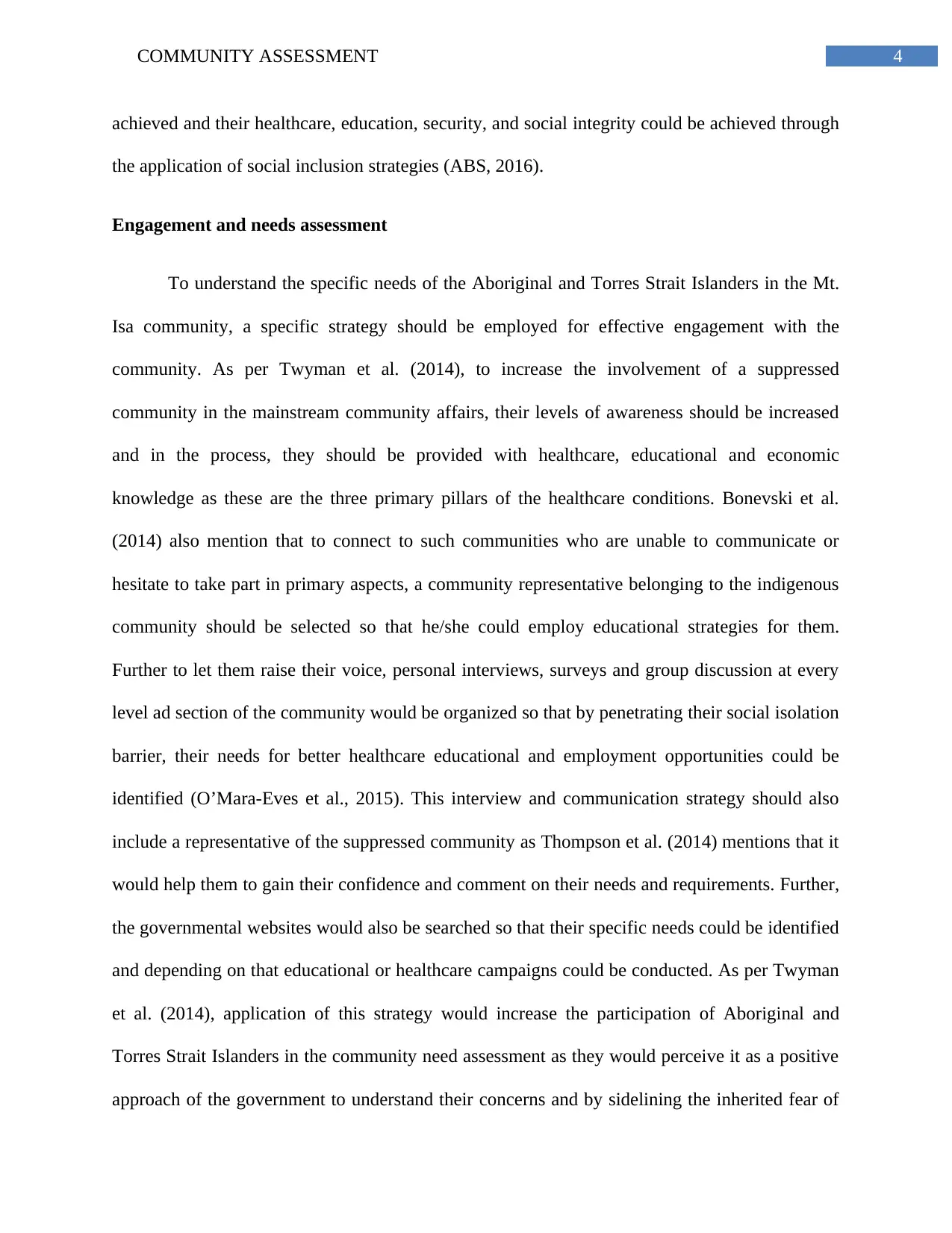
4COMMUNITY ASSESSMENT
achieved and their healthcare, education, security, and social integrity could be achieved through
the application of social inclusion strategies (ABS, 2016).
Engagement and needs assessment
To understand the specific needs of the Aboriginal and Torres Strait Islanders in the Mt.
Isa community, a specific strategy should be employed for effective engagement with the
community. As per Twyman et al. (2014), to increase the involvement of a suppressed
community in the mainstream community affairs, their levels of awareness should be increased
and in the process, they should be provided with healthcare, educational and economic
knowledge as these are the three primary pillars of the healthcare conditions. Bonevski et al.
(2014) also mention that to connect to such communities who are unable to communicate or
hesitate to take part in primary aspects, a community representative belonging to the indigenous
community should be selected so that he/she could employ educational strategies for them.
Further to let them raise their voice, personal interviews, surveys and group discussion at every
level ad section of the community would be organized so that by penetrating their social isolation
barrier, their needs for better healthcare educational and employment opportunities could be
identified (O’Mara-Eves et al., 2015). This interview and communication strategy should also
include a representative of the suppressed community as Thompson et al. (2014) mentions that it
would help them to gain their confidence and comment on their needs and requirements. Further,
the governmental websites would also be searched so that their specific needs could be identified
and depending on that educational or healthcare campaigns could be conducted. As per Twyman
et al. (2014), application of this strategy would increase the participation of Aboriginal and
Torres Strait Islanders in the community need assessment as they would perceive it as a positive
approach of the government to understand their concerns and by sidelining the inherited fear of
achieved and their healthcare, education, security, and social integrity could be achieved through
the application of social inclusion strategies (ABS, 2016).
Engagement and needs assessment
To understand the specific needs of the Aboriginal and Torres Strait Islanders in the Mt.
Isa community, a specific strategy should be employed for effective engagement with the
community. As per Twyman et al. (2014), to increase the involvement of a suppressed
community in the mainstream community affairs, their levels of awareness should be increased
and in the process, they should be provided with healthcare, educational and economic
knowledge as these are the three primary pillars of the healthcare conditions. Bonevski et al.
(2014) also mention that to connect to such communities who are unable to communicate or
hesitate to take part in primary aspects, a community representative belonging to the indigenous
community should be selected so that he/she could employ educational strategies for them.
Further to let them raise their voice, personal interviews, surveys and group discussion at every
level ad section of the community would be organized so that by penetrating their social isolation
barrier, their needs for better healthcare educational and employment opportunities could be
identified (O’Mara-Eves et al., 2015). This interview and communication strategy should also
include a representative of the suppressed community as Thompson et al. (2014) mentions that it
would help them to gain their confidence and comment on their needs and requirements. Further,
the governmental websites would also be searched so that their specific needs could be identified
and depending on that educational or healthcare campaigns could be conducted. As per Twyman
et al. (2014), application of this strategy would increase the participation of Aboriginal and
Torres Strait Islanders in the community need assessment as they would perceive it as a positive
approach of the government to understand their concerns and by sidelining the inherited fear of

5COMMUNITY ASSESSMENT
discrimination, they would be able to take active part in the governmental or non-governmental
assessments for their growth and development.
Health promotion planning
After conducting the detailed communication and community need assessment for
identification of their healthcare and educational needs, those data would be used for healthcare
and educational promotional plan for the Aboriginal and Torres Strait Islanders in Mt. Isa
community (Durey et al., 2016). In this process, all the healthcare professionals of the
government healthcare facilities would be asked to volunteer for the healthcare needs of the
vulnerable group and few aboriginal healthcare professionals, counselors and educators would be
employed for the healthcare promotional event (Lowell et al., 2015). Further, few of the local
individuals who are vocal about the need and requirement of the community would be asked to
spread awareness about the healthcare promotional program voluntarily. Moreover, to include
the governmental representatives in the promotional events, all the data collected from the
healthcare promotional program would be provided to the local government authorities. As per
their support, authority for local governmental community halls (municipal halls educational
institutes) and their healthcare instruments would be asked for few days so that with the use of
these effective healthcare promotional program could be developed (Freeman et al., 2014).
Further, all the participants of the community would be asked to take part in the educational and
financial and social aspects of the community health promotional program so that this
community and their thought and belief about healthcare could be strengthened. Further, through
counseling and communication-related interventions; healthcare professionals would be able to
understand the mental and psychological aspect of their thinking (Kales, Gitlin & Lyketsos,
2015). Hence, application of a specific healthcare promotional program for the healthcare
discrimination, they would be able to take active part in the governmental or non-governmental
assessments for their growth and development.
Health promotion planning
After conducting the detailed communication and community need assessment for
identification of their healthcare and educational needs, those data would be used for healthcare
and educational promotional plan for the Aboriginal and Torres Strait Islanders in Mt. Isa
community (Durey et al., 2016). In this process, all the healthcare professionals of the
government healthcare facilities would be asked to volunteer for the healthcare needs of the
vulnerable group and few aboriginal healthcare professionals, counselors and educators would be
employed for the healthcare promotional event (Lowell et al., 2015). Further, few of the local
individuals who are vocal about the need and requirement of the community would be asked to
spread awareness about the healthcare promotional program voluntarily. Moreover, to include
the governmental representatives in the promotional events, all the data collected from the
healthcare promotional program would be provided to the local government authorities. As per
their support, authority for local governmental community halls (municipal halls educational
institutes) and their healthcare instruments would be asked for few days so that with the use of
these effective healthcare promotional program could be developed (Freeman et al., 2014).
Further, all the participants of the community would be asked to take part in the educational and
financial and social aspects of the community health promotional program so that this
community and their thought and belief about healthcare could be strengthened. Further, through
counseling and communication-related interventions; healthcare professionals would be able to
understand the mental and psychological aspect of their thinking (Kales, Gitlin & Lyketsos,
2015). Hence, application of a specific healthcare promotional program for the healthcare
⊘ This is a preview!⊘
Do you want full access?
Subscribe today to unlock all pages.

Trusted by 1+ million students worldwide

6COMMUNITY ASSESSMENT
improvement of Aboriginal and Torres Strait Islanders of the Mt. Isa community would be
conducted so that without any hesitation, these communities could take part in the healthcare
community assessment program (Durey et al., 2016). Further, it would influence them to take
part in educational and healthcare process and they would be able to achieve sustainable
development.
Conclusion
Community need assessment is the process that helps the assessor to understand the
community, its social determinants of health, its social structure, education, and healthcare
achievements, and hence is able to understand the needs and hindrance of the community. In this
process, the community of Mt. Isa was assessed and three social determinants of health such as
their social structure, their education, and employment were selected for analysis. Further, by
choosing the Aboriginal and Torres Strait Islanders as the vulnerable group of the community.
Further through detailed analysis of their needs and requirements, the need of the population was
assessed.
improvement of Aboriginal and Torres Strait Islanders of the Mt. Isa community would be
conducted so that without any hesitation, these communities could take part in the healthcare
community assessment program (Durey et al., 2016). Further, it would influence them to take
part in educational and healthcare process and they would be able to achieve sustainable
development.
Conclusion
Community need assessment is the process that helps the assessor to understand the
community, its social determinants of health, its social structure, education, and healthcare
achievements, and hence is able to understand the needs and hindrance of the community. In this
process, the community of Mt. Isa was assessed and three social determinants of health such as
their social structure, their education, and employment were selected for analysis. Further, by
choosing the Aboriginal and Torres Strait Islanders as the vulnerable group of the community.
Further through detailed analysis of their needs and requirements, the need of the population was
assessed.
Paraphrase This Document
Need a fresh take? Get an instant paraphrase of this document with our AI Paraphraser

7COMMUNITY ASSESSMENT
References
ABS. (2016). Mount Isa (C) : Region Data Summary. Retrieved from
http://stat.abs.gov.au/itt/r.jsp?
RegionSummary®ion=35300&dataset=ABS_REGIONAL_LGA&geoconcept=REGI
ON&datasetASGS=ABS_REGIONAL_ASGS&datasetLGA=ABS_REGIONAL_LGA&
regionLGA=REGION®ionASGS=REGION
Becker, K. L. (2015). Conducting community health needs assessments in rural communities:
Lessons learned. Health promotion practice, 16(1), 15-19. DOI:
https://doi.org/10.1177%2F1524839914555887
Bonevski, B., Randell, M., Paul, C., Chapman, K., Twyman, L., Bryant, J., ... & Hughes, C.
(2014). Reaching the hard-to-reach: a systematic review of strategies for improving
health and medical research with socially disadvantaged groups. BMC medical research
methodology, 14(1), 42. DOI: https://doi.org/10.1186/1471-2288-14-42
Durey, A., McEvoy, S., Swift-Otero, V., Taylor, K., Katzenellenbogen, J., & Bessarab, D.
(2016). Improving healthcare for Aboriginal Australians through effective engagement
between community and health services. BMC health services research, 16(1), 224. DOI:
https://doi.org/10.1186/s12913-016-1497-0
Freeman, T., Edwards, T., Baum, F., Lawless, A., Jolley, G., Javanparast, S., & Francis, T.
(2014). Cultural respect strategies in Australian Aboriginal primary health care services:
beyond education and training of practitioners. Australian and New Zealand Journal of
Public Health, 38(4), 355-361. DOI: https://doi.org/10.1111/1753-6405.12231
References
ABS. (2016). Mount Isa (C) : Region Data Summary. Retrieved from
http://stat.abs.gov.au/itt/r.jsp?
RegionSummary®ion=35300&dataset=ABS_REGIONAL_LGA&geoconcept=REGI
ON&datasetASGS=ABS_REGIONAL_ASGS&datasetLGA=ABS_REGIONAL_LGA&
regionLGA=REGION®ionASGS=REGION
Becker, K. L. (2015). Conducting community health needs assessments in rural communities:
Lessons learned. Health promotion practice, 16(1), 15-19. DOI:
https://doi.org/10.1177%2F1524839914555887
Bonevski, B., Randell, M., Paul, C., Chapman, K., Twyman, L., Bryant, J., ... & Hughes, C.
(2014). Reaching the hard-to-reach: a systematic review of strategies for improving
health and medical research with socially disadvantaged groups. BMC medical research
methodology, 14(1), 42. DOI: https://doi.org/10.1186/1471-2288-14-42
Durey, A., McEvoy, S., Swift-Otero, V., Taylor, K., Katzenellenbogen, J., & Bessarab, D.
(2016). Improving healthcare for Aboriginal Australians through effective engagement
between community and health services. BMC health services research, 16(1), 224. DOI:
https://doi.org/10.1186/s12913-016-1497-0
Freeman, T., Edwards, T., Baum, F., Lawless, A., Jolley, G., Javanparast, S., & Francis, T.
(2014). Cultural respect strategies in Australian Aboriginal primary health care services:
beyond education and training of practitioners. Australian and New Zealand Journal of
Public Health, 38(4), 355-361. DOI: https://doi.org/10.1111/1753-6405.12231
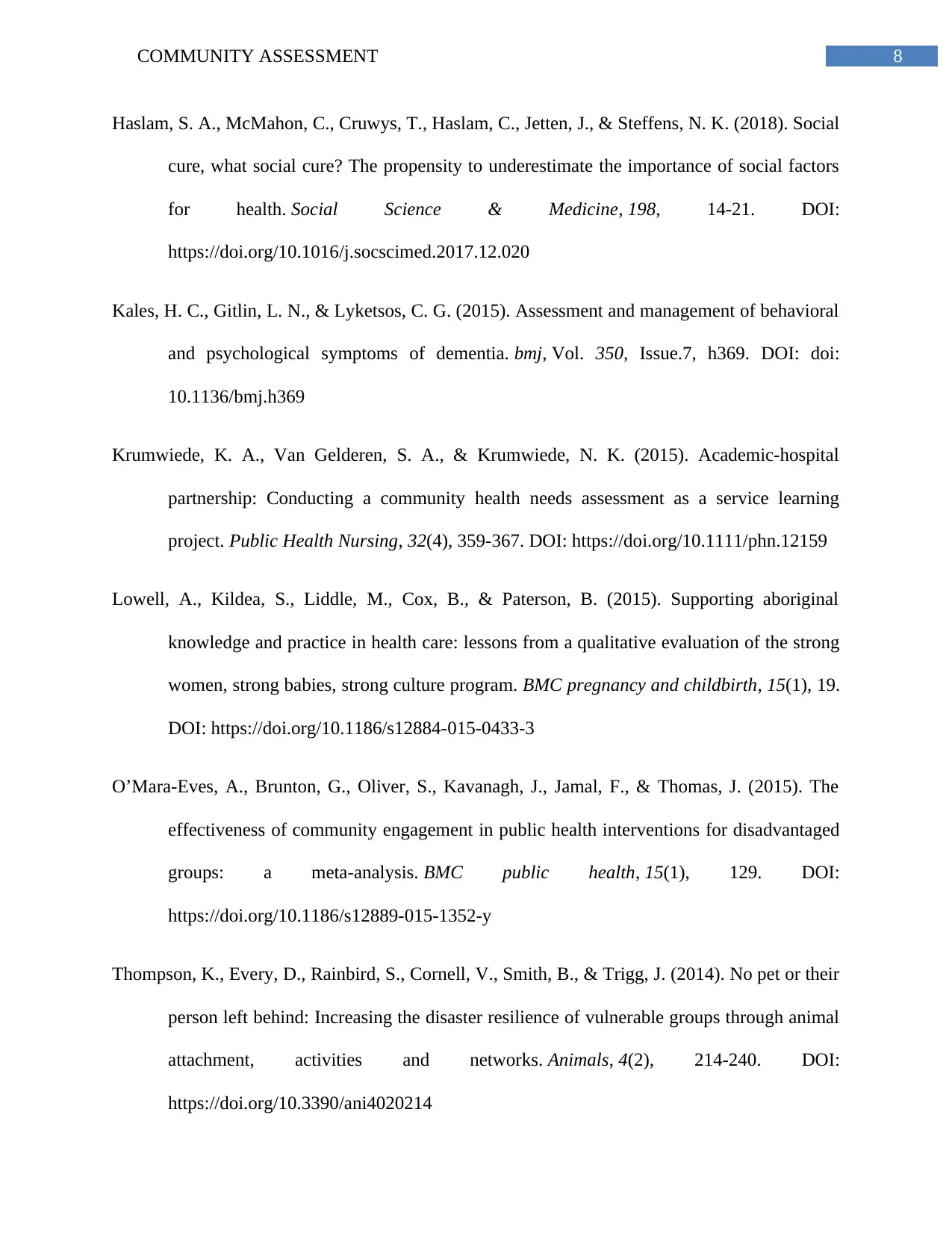
8COMMUNITY ASSESSMENT
Haslam, S. A., McMahon, C., Cruwys, T., Haslam, C., Jetten, J., & Steffens, N. K. (2018). Social
cure, what social cure? The propensity to underestimate the importance of social factors
for health. Social Science & Medicine, 198, 14-21. DOI:
https://doi.org/10.1016/j.socscimed.2017.12.020
Kales, H. C., Gitlin, L. N., & Lyketsos, C. G. (2015). Assessment and management of behavioral
and psychological symptoms of dementia. bmj, Vol. 350, Issue.7, h369. DOI: doi:
10.1136/bmj.h369
Krumwiede, K. A., Van Gelderen, S. A., & Krumwiede, N. K. (2015). Academic‐hospital
partnership: Conducting a community health needs assessment as a service learning
project. Public Health Nursing, 32(4), 359-367. DOI: https://doi.org/10.1111/phn.12159
Lowell, A., Kildea, S., Liddle, M., Cox, B., & Paterson, B. (2015). Supporting aboriginal
knowledge and practice in health care: lessons from a qualitative evaluation of the strong
women, strong babies, strong culture program. BMC pregnancy and childbirth, 15(1), 19.
DOI: https://doi.org/10.1186/s12884-015-0433-3
O’Mara-Eves, A., Brunton, G., Oliver, S., Kavanagh, J., Jamal, F., & Thomas, J. (2015). The
effectiveness of community engagement in public health interventions for disadvantaged
groups: a meta-analysis. BMC public health, 15(1), 129. DOI:
https://doi.org/10.1186/s12889-015-1352-y
Thompson, K., Every, D., Rainbird, S., Cornell, V., Smith, B., & Trigg, J. (2014). No pet or their
person left behind: Increasing the disaster resilience of vulnerable groups through animal
attachment, activities and networks. Animals, 4(2), 214-240. DOI:
https://doi.org/10.3390/ani4020214
Haslam, S. A., McMahon, C., Cruwys, T., Haslam, C., Jetten, J., & Steffens, N. K. (2018). Social
cure, what social cure? The propensity to underestimate the importance of social factors
for health. Social Science & Medicine, 198, 14-21. DOI:
https://doi.org/10.1016/j.socscimed.2017.12.020
Kales, H. C., Gitlin, L. N., & Lyketsos, C. G. (2015). Assessment and management of behavioral
and psychological symptoms of dementia. bmj, Vol. 350, Issue.7, h369. DOI: doi:
10.1136/bmj.h369
Krumwiede, K. A., Van Gelderen, S. A., & Krumwiede, N. K. (2015). Academic‐hospital
partnership: Conducting a community health needs assessment as a service learning
project. Public Health Nursing, 32(4), 359-367. DOI: https://doi.org/10.1111/phn.12159
Lowell, A., Kildea, S., Liddle, M., Cox, B., & Paterson, B. (2015). Supporting aboriginal
knowledge and practice in health care: lessons from a qualitative evaluation of the strong
women, strong babies, strong culture program. BMC pregnancy and childbirth, 15(1), 19.
DOI: https://doi.org/10.1186/s12884-015-0433-3
O’Mara-Eves, A., Brunton, G., Oliver, S., Kavanagh, J., Jamal, F., & Thomas, J. (2015). The
effectiveness of community engagement in public health interventions for disadvantaged
groups: a meta-analysis. BMC public health, 15(1), 129. DOI:
https://doi.org/10.1186/s12889-015-1352-y
Thompson, K., Every, D., Rainbird, S., Cornell, V., Smith, B., & Trigg, J. (2014). No pet or their
person left behind: Increasing the disaster resilience of vulnerable groups through animal
attachment, activities and networks. Animals, 4(2), 214-240. DOI:
https://doi.org/10.3390/ani4020214
⊘ This is a preview!⊘
Do you want full access?
Subscribe today to unlock all pages.

Trusted by 1+ million students worldwide
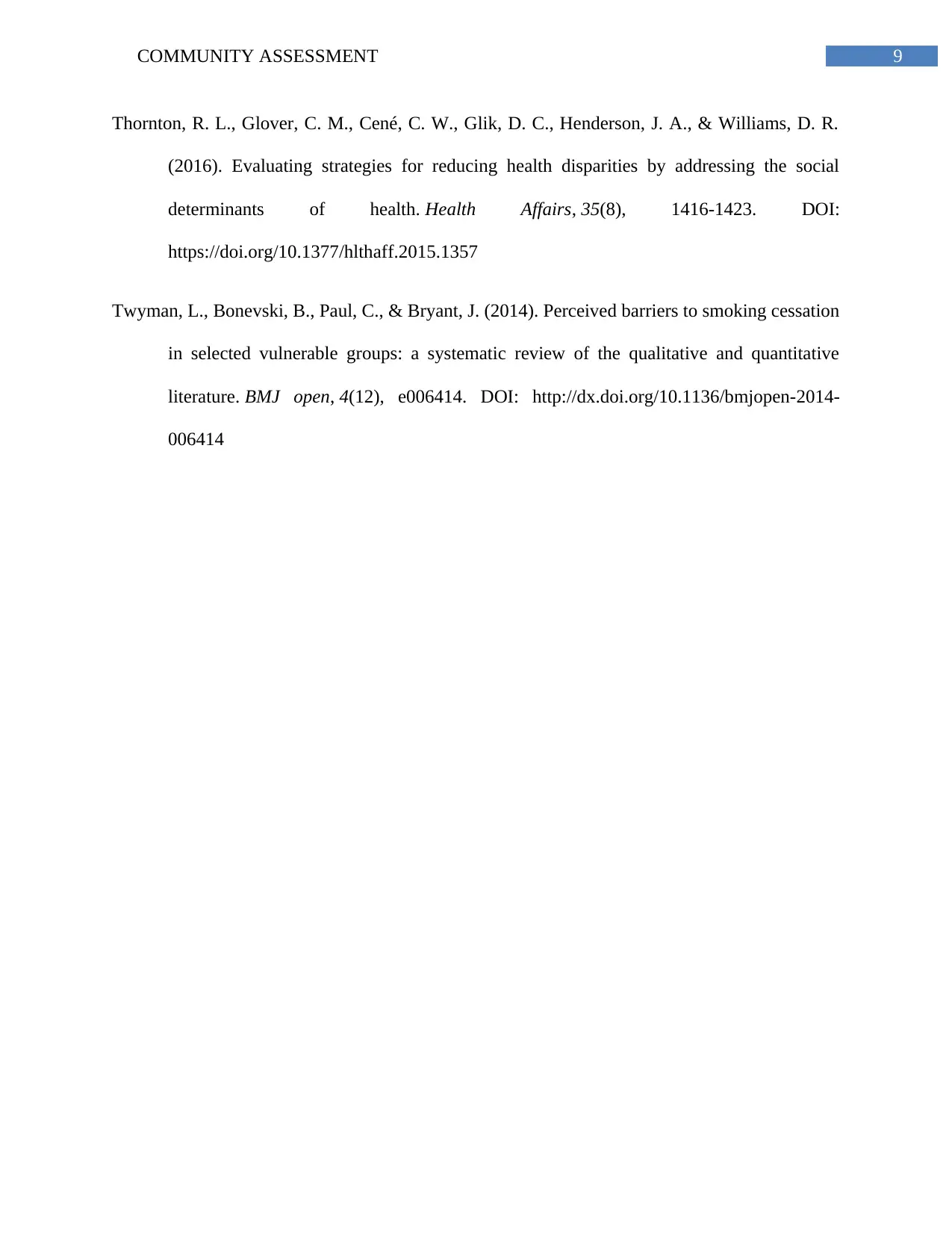
9COMMUNITY ASSESSMENT
Thornton, R. L., Glover, C. M., Cené, C. W., Glik, D. C., Henderson, J. A., & Williams, D. R.
(2016). Evaluating strategies for reducing health disparities by addressing the social
determinants of health. Health Affairs, 35(8), 1416-1423. DOI:
https://doi.org/10.1377/hlthaff.2015.1357
Twyman, L., Bonevski, B., Paul, C., & Bryant, J. (2014). Perceived barriers to smoking cessation
in selected vulnerable groups: a systematic review of the qualitative and quantitative
literature. BMJ open, 4(12), e006414. DOI: http://dx.doi.org/10.1136/bmjopen-2014-
006414
Thornton, R. L., Glover, C. M., Cené, C. W., Glik, D. C., Henderson, J. A., & Williams, D. R.
(2016). Evaluating strategies for reducing health disparities by addressing the social
determinants of health. Health Affairs, 35(8), 1416-1423. DOI:
https://doi.org/10.1377/hlthaff.2015.1357
Twyman, L., Bonevski, B., Paul, C., & Bryant, J. (2014). Perceived barriers to smoking cessation
in selected vulnerable groups: a systematic review of the qualitative and quantitative
literature. BMJ open, 4(12), e006414. DOI: http://dx.doi.org/10.1136/bmjopen-2014-
006414
1 out of 10
Related Documents
Your All-in-One AI-Powered Toolkit for Academic Success.
+13062052269
info@desklib.com
Available 24*7 on WhatsApp / Email
![[object Object]](/_next/static/media/star-bottom.7253800d.svg)
Unlock your academic potential
Copyright © 2020–2025 A2Z Services. All Rights Reserved. Developed and managed by ZUCOL.





